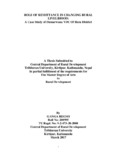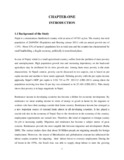Please use this identifier to cite or link to this item:
https://elibrary.tucl.edu.np/handle/123456789/2347| Title: | Role of Remittance in Changing Rural Livelihood: A Case Study of Dumarwana Vdc of Bara District |
| Authors: | Regmi, Ganga |
| Keywords: | Remittance;Livelihood;Bara;Rural poverty |
| Issue Date: | Mar-2017 |
| Publisher: | Central Department of Rural Development Tribhuvan University Kirtipur, Kathmandu |
| Abstract: | This study was carried out to assess the local people perception on remittance, to identify the role on rural livelihood. Study was conducted in Dumarwana VDC of Bara District, Nepal was conduct with the objectives to analyze the impact of remittance on rural livelihood, accessthe contribution of remittance in poverty reduction on rural areas and analyze the factors related to the use of remittance in Dumarwana VDC of Bara District. This study is mainly based in the primary information and the data were collected using the technique of household survey with the help of questionnaire and interview. There was 4416 population in VDC. Out of total households 820 households were receiving remittance money. Among them 60 households were selected as the sample for study by using random samples. Most of the households from the study area were receiving remittance. In the study area it was found that lama 30%, Brahmin 21.66%, and Magar 6.66% were caste of the study area. Remittance was the main source of livelihood of this study area. Of the total, 35% foreign migrant worker were spending their remittance in HHs expenditure, 20% spend for education. After remittance foreign migrant worker households economic condition has improved through remittance. Similarly, there was significant improvement in the foreign migrant worker household going for better health check-up in private hospital and started to send their children in school, college and university after receiving the remittance in the study area. In the study area, remittance income has an effective tool in reducing the poverty. The living standard of the people is gradually changing. People are now getting the proper health and facilities and their educational status is also gradually increasing. The income of the family has been raised up ultimately uplifting the living standard of the living under the poverty line. vii Some utilize in productive from our side like income coming from remittance should be utilizes in productive sector like business, agriculture, agro forestry, real estate (land purchase and housing construction) etc, there should be some vocational training institution in the local area for their skill development and so on. Result of the study suggests that remittance helps to reduce rural poverty and helps rural development. |
| URI: | http://elibrary.tucl.edu.np/handle/123456789/2347 |
| Appears in Collections: | Rural Development |
Files in This Item:
| File | Description | Size | Format | |
|---|---|---|---|---|
| CoverG.pdf | 180.43 kB | Adobe PDF |  View/Open | |
| Thesis.pdf | 677.64 kB | Adobe PDF |  View/Open |
Items in DSpace are protected by copyright, with all rights reserved, unless otherwise indicated.
